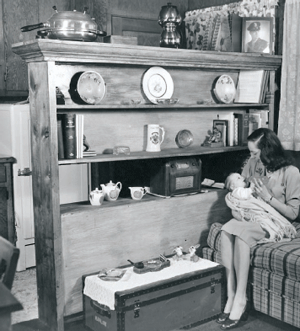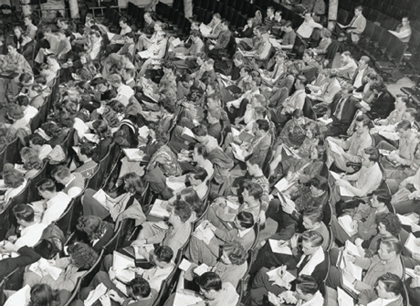With the sudden and steep increase in enrollment, most institutions searched frantically for qualified teachers. Colleges and universities in California, for example, needed to add at least 5,820 instructors to its faculty of 7,802 just to accommodate the GI matriculants in 1946. Moreover, search committees found that the pickings were slim. Given low salaries and a booming economy, a substantial number of the college professors who had served in the armed forces decided not to return to the classroom. In addition, the disruption of graduate education during the war had left the pipeline of PhDs cracked and leaky.
Concerns that the GI Bill would lower academic standards proved groundless. In fact, students at the University of California referred to veterans as 'D.A.R.s (Damned Average Raisers).'Colleges and universities improvised. At Penn State, high school teachers moonlighted by teaching fully accredited courses to 900 students at extension centers. The University of Iowa adopted practices that were replicated throughout the nation. In the fall of 1946, Iowa's College of Liberal Arts hired ninety-one temporary instructors, many of them graduate students who agreed to postpone research on their master's and doctoral theses. Thirty-eight of them had no prior teaching experience. These young teachers joined the tenured faculty in offering large lecture courses, leading discussion sections, and counseling veterans. Large courses became the norm, as did multiple-choice exams that were graded by machine. Personal contact between professor and student was minimal, Life reported, but veterans eager to "speed up their education" did not much mind.
GI Bill students were remarkably successful learners. About a quarter of the veterans who enrolled in a college or university did not complete a degree, a much smaller drop-out rate than in the civilian population. Exit interviews suggest that most of those who left prematurely did so for financial reasons. Few GIs "flunked out." Moreover, a surprisingly small percentage of veterans failed to adjust to campus life. "Where are the psychiatric problems we had been led to expect?" an instructor at Princeton asked. "Our veterans are normal, fine youths."

Veterans quickly acquired a reputation as mature, serious students. Instead of "taking a ride on Uncle Sam's generosity," they attended virtually every class, intently took notes, and asked questions. "The window-gazers and hibernators have vanished," one Harvard professor exclaimed. "This crowd never takes its eyes off you." Civilian students did not disagree, though they did not always share the faculty's growing enthusiasm for academically oriented veterans. "They're grinds, every one of them," a civilian senior at Lehigh University in Bethlehem, Pennsylvania, complained, "It's books, books, books all the time. They study so hard we have to slave to keep up with them."
The veterans' performance helped shape popular perceptions of the GI Bill as far-sighted legislation by making equal opportunity a reality and challenging assumptions about who could benefit from a college education. By mid-1946 even James Bryant Conant, Harvard's president, the one-time critic of federal funding of higher education for World War II veterans, was eating some crow. The GI Bill, Conant now believed, was "a heartening sign that the democratic process of social mobility is energetically at work, piercing the class barriers which, even in America, have tended to keep a college education the prerogative of the few."
Concerns that the GI Bill would lower academic standards proved groundless as well. In fact, students at the University of California referred to veterans as "D.A.R.s (Damned Average Raisers)." "The G.I.s are hogging the honor rolls and the deans' lists," Benjamin Fine reported in the New York Times after a nationwide tour of college campuses in the fall of 1947. That spring a mere thirty-five of the 6,010 veterans at the University of Minnesota were dismissed because of poor grades, one-twentieth of the discharge rate to which the institution was accustomed.

Even more than good grades, the ease with which veterans adapted to campus life assumed almost mythic dimensions. Profiles of GI Bill students were ubiquitous in the nation's newspapers and magazines. They did not always follow Norman Rockwell, who depicted a former grunt, perched in the shuttered windowsill of his college dorm room, overlooking the clock tower on the quad, puffing on a pipe while reading a book, with his golf bag leaning against the wall. However, virtually without exception, student-veterans were portrayed as gracious and grouseless white males. These images became iconic—and shaped popular perceptions of the GI Bill for decades.
About half of the GI Bill students in college were married, and their travails and triumphs dominated media coverage. At the University of Iowa, according to a Life article, accompanied by photographs taken by Margaret Bourke-White '27, about 170 married veterans rented furnished trailers for $25 a month. While they waited for a barracks or a Quonset hut with running water, the families used communal baths and washrooms at the Hawk-eye Trailer Camp. When the men studied or went off to class, the "wives cheerfully wash, starch, and iron their babies' white ruffles, hang bright chintz curtains, and wax the trailer floors." With the families sharing washrooms, clotheslines, and garbage disposals, the article reported, "there are no secrets, no differences, and no Joneses to keep up with."
Vet School
From the 1946 Cornellian
'Cornell happily welcomes many veterans, who, for the first time in many months have an opportunity to resume their schooling. Some of the veterans are starting where they left off before the war, while others are just beginning their college life. Approximately 1,300 veterans have enrolled this year. Of this number 160 have been at Cornell before the opening of the fall term after discharge from service; 380 were either Cornellians who had taken leave to go into service or were here in the V-12 program; 400 had college work elsewhere, but had never been at Cornell before; and 360 are entering freshmen. About 25 percent of these veterans are married, and most of them enrolled in the School of Industrial and Labor Relations, the College of Agriculture, and the College of Engineering.'


